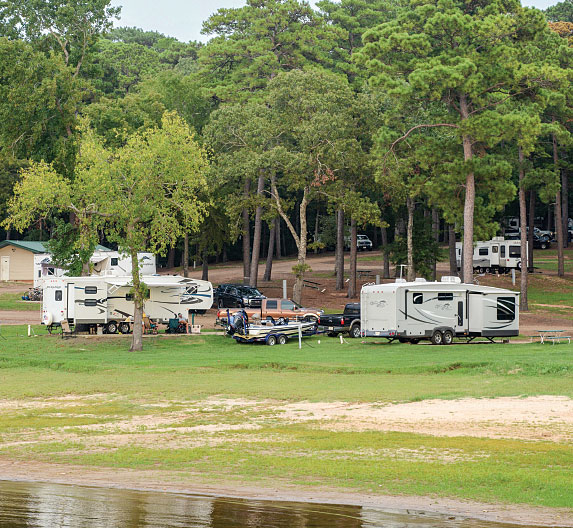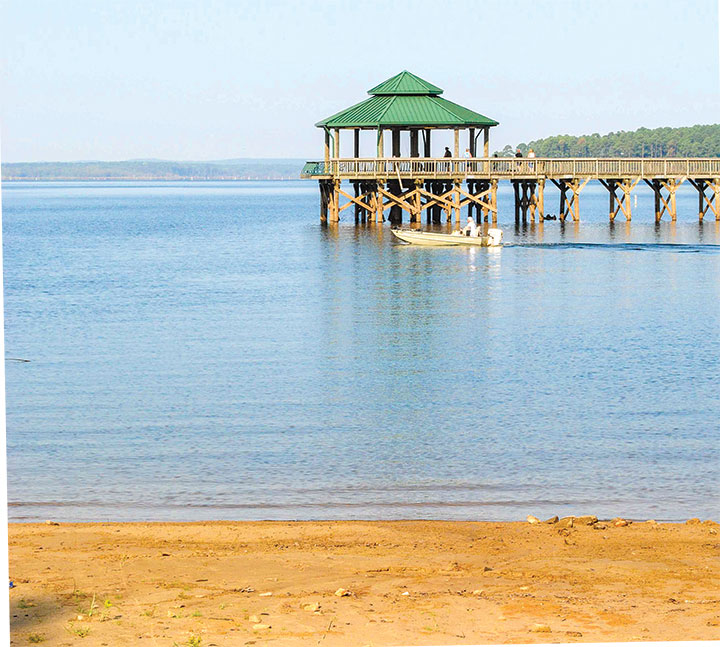Sharing the oldest-town distinction in their respective states, Nacogdoches, Texas, and Natchitoches, Louisiana, are steeped in legend and linked by an ancient road
Their names are so whimsically similar — Nacogdoches in Texas and Natchitoches in Louisiana — and they’re only about 100 miles apart. We wondered how the two might be related, and it turns out they’re “twins,” sharing a history that stretches back a dozen centuries and emerges from legend.
Nacogdoches and Natchitoches were, the legend goes, the adult twin sons of an old Caddo chief, living near the Sabine River. Nearing the end of his days, the chief gathered his sons to make a request: Nacogdoches and his family were to walk three days toward the setting sun, while Natchitoches (pronounced “Nack-a-tish”) and his family walked three days toward the rising sun. Then they were to stop and build homes, and establish tribes far enough apart that there’d be no fighting over hunting grounds.
Through the centuries the two tribes remained friends, trading partners, linked by a well-traveled path. The path later was used by the Spanish as the eastern end of their El Camino Real de los Tejas, a 2,500-mile “royal road” that began in Mexico City and ended in today’s Louisiana. The Spanish called the Caddos “Tejas,” from the Caddo word “taysha,” or “friend,” which was later anglicized to “Texas.”
My husband, Guy, and I recently visited Nacogdoches and Natchitoches, and followed the historic Camino Real, a designated national historic trail, between the two.
Small-Town Charm in Nacogdoches
Quaint Nacogdoches, a town of 34,000 in the Piney Woods of East Texas, was still a Caddo settlement in 1716, when a Spanish mission was established there. In 1773, the Spanish government ordered all East Texas missions abandoned. Six years later, Spain reoccupied the area, and trader Antonio Gil Y’Barbo brought a group of settlers to the empty mission.
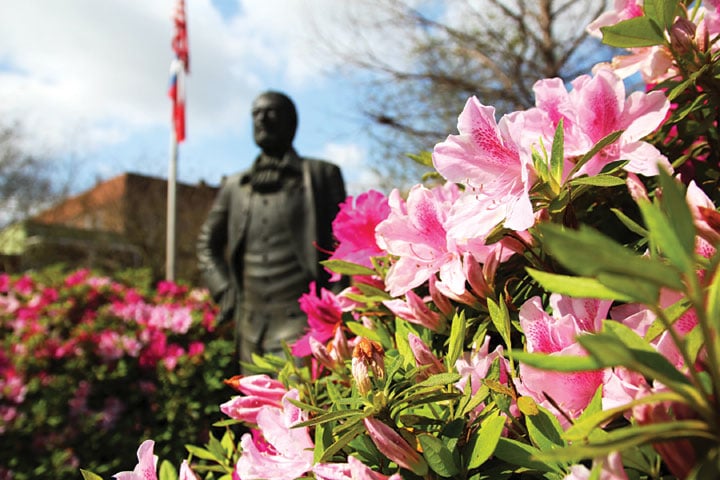
A statue of the town’s founder, Antonio Gil Y’Barbo, stands downtown in Nacogdoches, Texas. Photos by Guy Selbert
That year, 1779, Spain designated the community a town, making Nacogdoches the first town in Texas, with Y’Barbo its Lieutenant Governor. The stone house he built — which also served as a fort, trading post, church, jail and saloon — is gone. But a 1936 replica Old Stone Fort is on the grounds of nearby Stephen F. Austin University. It includes a museum that interprets Nacogdoches history.
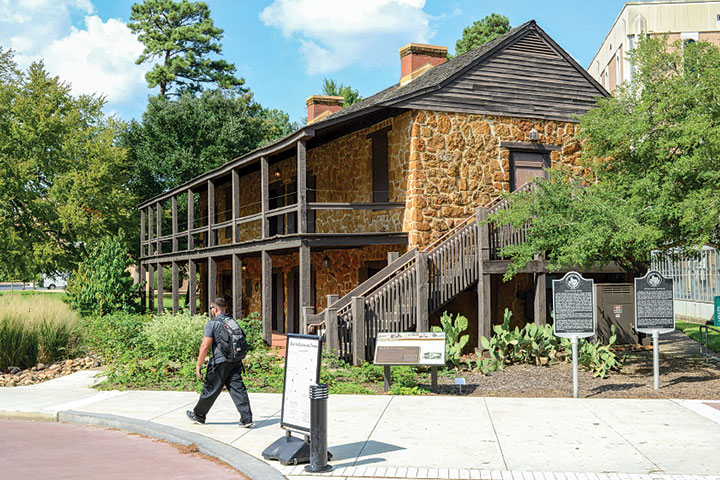
The Old Stone Fort, a replica of the town’s founder, Antonio Gil Y’Barbo’s house, is on the grounds of Stephen F. Austin State University in Nacogdoches, Texas.
Joanna Temple of the visitor center explained that none of Nacogdoches’ original buildings survive, but several historic homes and other 19th-century structures can be visited. Most are on the National Register of Historic Places.
The oldest building still on its original site is the 1830 Sterne-Hoya House Museum and Library a few blocks east. It was home to Nicholas Sterne, a leader in Texas’ fight for independence, and the library is popular with visitors interested in Texas genealogy.
The best way to explore downtown Nacogdoches is on foot. Attractions include the Nacogdoches Fire Museum, Nacogdoches Farmer’s Market and the elegant Nacogdoches Railroad Depot. A placard on the City Hall identifies the site of Sam Houston’s first home in Texas.
Dolli’s Diner, in a 19th-century brick building, is across the road, and we recommend it for lunch. The hamburgers are huge and delicious, with the most wonderful bread.
Nearby is Heart of Texas Gift Gallery, a world of metal armadillos, cowboy hats and boots, maps of early Texas and more. Owner Gerry Larabee said the 1890 building was originally a bank, then a silent-movie theater. She bought it 20 years ago, and now, with her “assistants” Gracie, a beautiful golden retriever, and Buster, a rambunctious fox terrier puppy, sells every imaginable kind of Texas memorabilia.
The Cole Art Center exhibit hall occupies the former Old Opera House, which has a great story to tell. Local writer Tim Bryant of Bosslight Bookstore explained that one afternoon in 1910, four musical brothers called the Nightingales were performing there. Suddenly, the city’s only auto careened past and backfired, terrifying a mule tethered nearby. He broke free, causing a commotion, and, inexplicably, a passerby ran into the opera house shouting, “Runaway mule!”
The audience rushed to the windows, annoying the musicians. One of them, Julius Marx, “promptly launched into a fit of comedy that segued into a chorus of ‘Nacogdoches is full of roaches!’” The other brothers joined in, the audience loved it, and “a career in comedy was born.” As Groucho, Harpo, Zeppo and Chico, the four “transformed the world of comedy with their outrageous routines and films, and in their classic Duck Soup, saluted their roots in Nacogdoches,” Bryant said.
Other attractions include designated walking tours of historical buildings, statues and the Ruby M. Mize Azalea Garden with more than 7,000 azaleas (Nacogdoches is known as the Garden Capital of Texas). Our favorite was the tour at Millard’s Crossing Historic Village with 37 acres of living history, established in the 1970s. Director Jessica Pinkert said the 14 historic buildings, moved from elsewhere to replicate a town, “display a spectrum of 19th-century Texas architecture,” from log cabins to elegant Victorian homes.
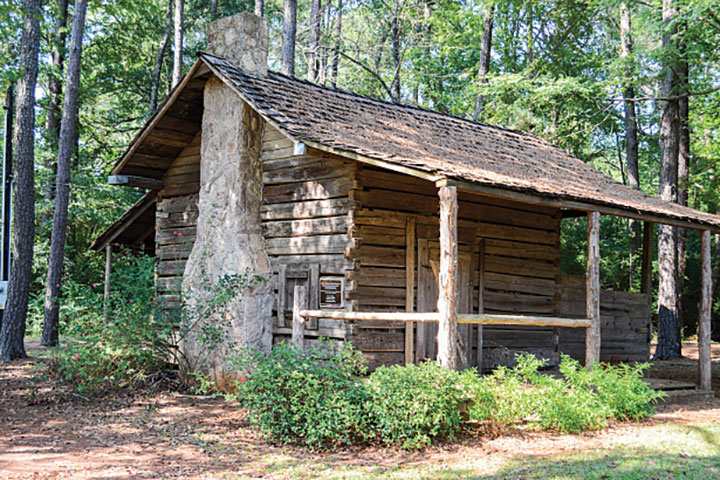
The Gaines-Oliphint House in tiny Pendleton Harbor is said to be the oldest standing log structure in Texas.
Meandering Along El Camino Real
Caddo Mounds State Historic Site, 30 miles west, was built more than 1,200 years ago. Nearly destroyed by a tornado in April 2019, it’s currently closed but will be rebuilt, Joanna Temple said.
She explained that the Caddos came to the region from the Mississippi River Valley around 800 A.D. Today’s El Camino Real (Highway 21 in Texas and Highway 6 in Louisiana) retraces the Caddos’ ancient trail that became Spain’s missionary and military route, and later an immigrant path. Its 111 miles, well-marked with national historic trail signs, wind through rolling hills between the towns.
“Cradle of Texas” San Augustine, 35 miles east of Nacogdoches, is a town of 2,100, with a quaint courthouse square, elegant homes and interesting history. Joe Consford, owner of Hardware on the Square, is a wealth of information. He noted that a hardware store has stood on the site since 1836.
Across the street, just east of the limestone courthouse, is the 1919 San Augustine County Jail. It closed in 2000 and was later restored as a law-enforcement museum and research library. Among its many exhibits is a framed letter dated January 9, 1836, from David Crockett (he hated “Davy,” said guide Earline Boyd) to his “Dear Sone and daughter.” He wrote that he had “got through safe” to San Augustine. “Do not worry about me,” he continued, as “I am among my friends.” Two months later Crockett would be among the 200 Texians killed by Mexican troops at the Alamo in San Antonio.
East of San Augustine are several attractions with parking areas too small to maneuver a trailer. We recommend leaving it at a campground — in our case, Cypress Bend RV Park near Many, Louisiana, where we had a reservation.
Lobanillo Swales, 10 miles east of San Augustine, are the grassy, jumbled remnants of troughs — up to 12 feet deep and 20 feet wide — worn into the earth over several centuries by thousands of feet, hooves and wagon wheels that came through on this ancient missionary, military and migrant route. There’s a steep trail you can climb for high-up overlooks of what’s left of the old camino.
Ahead, at Pendleton Harbor, is the 1815 Gaines-Oliphint House, said to be the oldest standing log structure in the state. It was home from 1819 through 1843 to James Gaines, a signer of the Texas Declaration of Independence, who ran a tavern and ferry on the nearby Sabine River. Pioneer Trade Days is held at the house the third Saturday in April.
A ferry operated on the Sabine from 1795 to 1937, when the Gaines-Pendleton Bridge was built. Thirty years later, the river was dammed to create magnificent Toledo Bend Reservoir, a 185,000-acre lake offering a host of recreational activities. Today, 3-mile Pendleton Bridge crosses it into Louisiana.
We continued east on El Camino Real (Highway 6) to Many. Fort Jesup is ahead just off the old route (turning the RV around here involved some tricky backing up). The fort’s site was chosen by Zachary Taylor in 1822, and for the next 26 years, until the end of the Mexican War, the 82-building complex was one of the strongest garrisons in the country. The only remaining original building is the kitchen/mess hall, but the Officer’s Quarters has been rebuilt as a museum.
Next we headed through Robeline to Los Adaes State Historic Site, where a 1721 Spanish “presidio” and mission served as the capitol of the Spanish province of Tejas. No historic buildings remain, but are outlined; tours are by appointment.
Plantations, Forts and Meat Pies in Natchitoches
El Camino Real ends a few miles east at Natchitoches, population 18,000, Louisiana’s oldest town. Originally two log huts, it was founded in 1714 by French-Canadian Louis Juchereau de St. Denis as a trading post on the Red River. Fort St. Jean Baptiste, now a state historic site, was built to protect the post, which at the time stood on the French frontier, the Louisiana Territory. But after France’s 1763 defeat in the French and Indian War, the land was ceded to Spain.
Jeremy McCormic, an interpretive ranger at the fort, said the palisade and other buildings were reconstructed in 1979, according to original blueprints found in the 1930s in the French National Archives. The visitor center includes a diorama of a Caddo village and a copy of the transfer of the fort and post to the United States in 1804. McCormic explained that the fort and historic town are no longer on the Red River.
Natchitoches’ historic main street, with dozens of shops, sits high over the elegant riverfront. Kaffie-Frederick General Mercantile, the state’s oldest general store, has been continuously operating since it was founded in 1863. Now run by Luke Frederick, a descendant of one of the early owners, the cavernous store sells any-thing you can think of from cast-iron skillets, dog collars and silverware to bird feeders, wheelbarrows and wind chimes.
Nearby, the Louisiana Sports Hall of Fame and Northwest Louisiana History Museum share an unusual 27,000-square-foot facility. Scott Williams of the museum said the “louvered” exterior is intended to resemble plowed fields and the “sinuous stone” inside to suggest slow-moving rivers. Exhibits chronicle area history, and photos and other memorabilia tell of the feats of some 300 men and women on the hall’s roster.
South of town a designated auto tour along the Cane River winds past half a dozen historic plantation homes. Among the earliest is sprawling Melrose Plantation, established in 1796 by Louis Metoyer, the son of a freed slave and a trader at Fort St. Jean Baptiste. The original 1,200-acre plantation was a pecan orchard, said Jim Kilcoyne, a guide at what is now a 6-acre national historic landmark.
The only visitors on this occasion, we were given an extensive three-hour tour of the Big House, Yucca House, African House, a weaving cabin and the home of Clementine Hunter, a renowned primitive folk artist.
Though untrained as an artist, Hunter, who was “sometimes called the black Grandma Moses,” began painting around 1940, using oils a visiting artist had left behind. Over the years, until her death in 1988, she painted more than 4,000 works on canvas and 3,000 more “on anything that would stand still,” Kilcoyne said. Her murals, depicting life on a plantation, fill the upstairs walls of the African House.
Among Natchitoches’ many other attractions are more than three dozen restaurants, including several in the historic district serving the town’s famous meat pies. The deep-fried crescent-shaped turnovers of ground beef, pork or both, onions, peppers and garlic in a flaky wheat pastry are generally not available anywhere but Natchitoches. We recommend Lasyone’s — so good!
Natchitoches is famous for its annual Festival of Lights. The 94th event is scheduled for November 21 this year through January 6, 2021.
Rolling on the Cane River
Our last evening in town, we took a 90-minute narrated cruise on the Cane River Queen, a 50-passenger paddle wheeler that Captain Paul Lohr said took him six years to build. Churning placid water into millions of glittering rhinestones, the huge paddle propels the Queen 3 miles north to the dam and back, while narrator and local historian Julie Coleman tells the town’s story and points out attractions in the bucolic landscape.
One of them is the house where the 1989 movie Steel Magnolias was filmed. The story’s author, Robert Harling, lives at the restored 1830 Oaklawn Plantation on the Cane, south of Natchitoches.
There’s wildlife: We saw an alligator swimming and a handful of stately great white herons standing ankle-deep or gliding low over the water. It was getting dark, with lights flickering on along the shore when the trip was over.
If historic Natchitoches isn’t on picture postcards, it should be, at least the way it appeared from the boat as we chugged back to the dock. Sunset had transformed the main street into art, the row of quaint buildings silhouetted black and neatly framed against a background of fiery orange and amber.
Where To Stay and Play
Texas
Garrison
Eagle Nest Hidden Lake Resort is an 86-acre property located about 9 miles north of Nacogdoches. The resort offers 18 RV sites overlooking the lake and includes 30/50-amp electric service, water and sewer hookups for $40 per night. Fishing is available, and pets are welcome.
www.eaglenesthiddenlakeresort.com
Louisiana
Many
Cypress Bend Park includes 70 back-in sites and one pull-through, all with 30/50-amp electricity, water and sewer hookups. Waterfront sites cost $35 per night; others are $25.
www.toledobendlakecountry.com
Toledo Bend RV Resort and Cabins, a Good Sam Park, has 40 RV sites with large concrete patios and full hookups, a game room, pool, two boat launches and a nature trail to Toledo Bend Lake. Good Sam members get a discount on the nightly fees, which range from $44 to $54.
www.toledobendrvresortandcabins.com
Natchitoches
Grand Ecore RV Park, a Good Sam Park, offers 59 paved sites (24 pull-throughs), all with water, sewer, 20/30/50-amp electric service, a picnic table and a fire ring with a grill. There’s a playground, an accessible bathhouse, a picnic pavilion, a laundry facility and free high-speed Wi-Fi. Cost is $48 per night; $40 for Good Sam members.
www.grandecorervpark.com
For More Information
Nacogdoches, www.visitnacogdoches.org
Natchitoches, www.natchitochesla.gov

